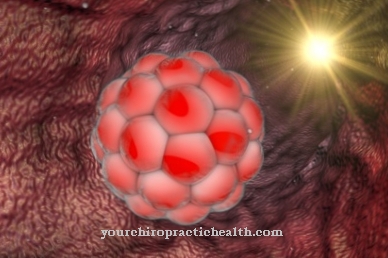The Defense reaction is also known as Immune response refers to and corresponds to the body's own processes for the elimination of foreign substances. If the organism recognizes a foreign substance as threatening, it extinguishes it with the help of plasma proteins and killer cells. In autoimmune diseases, the defense reaction is not directed against pathogens but incorrectly against the body's own tissue.
What is the defense reaction?

The human body reacts to a known or unknown antigen with an immune response. This natural reaction is also known as the defense reaction and forms the basis of the body's defense against bacteria and other pathogens.
Most immune reactions correspond to an innate and unspecific immune reaction. This means that they are not geared towards specific pathogens, but are generally directed against external stimuli in the organism. There are also specific immune reactions that are acquired later. One example of this is the learned immune response to specific antigens that the organism is already familiar with from the past.
In addition to cellular immune responses from T killer cells, antigen presenting cells and T helper cells, humoral immune responses also take place in the body. The expression of the humoral defense reaction refers to antibodies and antigens in the human body fluids.
As part of every defense reaction, the body fights foreign or endogenous cells. In this way, the immune system protects the organism from disease and ultimately even from death.
Function & task
The defense system is responsible for removing threatening foreign substances from the body. An immune response specifically targets pathogens such as viruses or bacteria. On the other hand, an immune response can also refer to pathologically altered cells of the own organism. This mechanism plays an important role in cancer cells, for example.
The innate immune response runs through hereditary structures and reacts mechanically to external stimuli. The specific defense reaction, on the other hand, uses acquired receptors in the body to identify stimuli. An almost unlimited number of these receptors form into specific pathogens. The organism uses the receptors to judge the threat of an exogenous stimulus on the basis of its experience.
If the stimulus is classified as harmless, there will be no immune reaction in the future. This phenomenon is also known as immune tolerance. It ensures that the immune system does not react to all substances in the environment.
Foreign substances penetrate the body permanently. If the immune system were to react to each of them, it would harm the organism rather than protect it. Differentiation via the receptors is therefore an important component for the functioning of the immune system.
A productive immune response is only triggered when a stimulus is actually recognized as threatening. This immune response is designed to eliminate the threat. The mechanisms on which this defense reaction is based are extremely diverse.
Complement systems of plasma proteins, for example, are found on numerous surfaces of the organism. The task of these proteins is to cover and destroy the surface of pathogens. To do this, they trigger inflammatory reactions that fight infections. In addition to killing pathogens, the complement system also takes over the marking of these pathogens. This makes them detectable for the body's killer cells.
The immune response also includes microbicidal substances that are released by cells outside the immune system to activate scavenger and killer cells. The B-lymphocytes meanwhile permanently produce antibodies. These antibodies bind to foreign structures in a highly specific manner as part of the defense reaction. Together, these individual reactions eliminate the dangerous substances from the organism.
Immunological overreactions are avoided by the body's own regulatory mechanisms. They would damage the body's own tissue too much and could trigger septic shock and, in the worst case, death. Without the regulatory units, the immune system could no longer maintain the balance between protective and damaging reactions.
You can find your medication here
➔ Medicines to strengthen the defense and immune systemIllnesses & ailments
The immune system is a highly complex apparatus that can cause numerous and very different complaints. For example, hypersensitivity reactions are conceivable.
Such overreactions usually correspond to septic or anaphylactic shocks. Anaphylactic shock can occur, for example, in the context of contact with chemical substances. In this context, the organism often reacts with circulatory failure or organ failure.
Septic shocks, on the other hand, can occur when the immune system triggers inflammatory reactions throughout the body. Such a reaction is usually due to infectious causes. Immunological, septic shocks can also occur in connection with an actual illness, for example in the context of toxic shock syndrome.
Further examples of diseases of the immune system are the so-called autoimmune diseases. In these diseases, the body's own and completely healthy cells trigger defense reactions. The receptors of the immune system incorrectly recognize their own tissue as threatening foreign bodies and attack healthy tissue structures.
Examples of such diseases are the inflammatory disease multiple sclerosis, which permanently attacks the central nervous system, and systemic lupus, which is directed against the skin, joints and kidneys.
Allergies are also faulty defense reactions. In this group of diseases, harmless substances from the environment falsely trigger an immune response.
Complaints regarding the body's own defense reaction can also occur in connection with immune tolerance. On the one hand, this tolerance is important so that the immune system is not overloaded and the organism is not unnecessarily burdened with inflammatory reactions. However, if the immune system develops an immune tolerance towards threatening substances, this can endanger the organism.
























.jpg)



